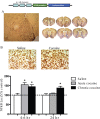Nuclear factor kappa B signaling regulates neuronal morphology and cocaine reward
- PMID: 19295158
- PMCID: PMC2677656
- DOI: 10.1523/JNEUROSCI.6173-08.2009
Nuclear factor kappa B signaling regulates neuronal morphology and cocaine reward
Abstract
Although chronic cocaine-induced changes in dendritic spines on nucleus accumbens (NAc) neurons have been correlated with behavioral sensitization, the molecular pathways governing these structural changes, and their resulting behavioral effects, are poorly understood. The transcription factor, nuclear factor kappa B (NFkappaB), is rapidly activated by diverse stimuli and regulates expression of many genes known to maintain cell structure. Therefore, we evaluated the role of NFkappaB in regulating cocaine-induced dendritic spine changes on medium spiny neurons of the NAc and the rewarding effects of cocaine. We show that chronic cocaine induces NFkappaB-dependent transcription in the NAc of NFkappaB-Lac transgenic mice. This induction of NFkappaB activity is accompanied by increased expression of several NFkappaB genes, the promoters of which show chromatin modifications after chronic cocaine exposure consistent with their transcriptional activation. To study the functional significance of this induction, we used viral-mediated gene transfer to express either a constitutively active or dominant-negative mutant of Inhibitor of kappa B kinase (IKKca or IKKdn), which normally activates NFkappaB signaling, in the NAc. We found that activation of NFkappaB by IKKca increases the number of dendritic spines on NAc neurons, whereas inhibition of NFkappaB by IKKdn decreases basal dendritic spine number and blocks the increase in dendritic spines after chronic cocaine. Moreover, inhibition of NFkappaB blocks the rewarding effects of cocaine and the ability of previous cocaine exposure to increase an animal's preference for cocaine. Together, these studies establish a direct role for NFkappaB pathways in the NAc to regulate structural and behavioral plasticity to cocaine.
Figures






Similar articles
-
Essential role of SIRT1 signaling in the nucleus accumbens in cocaine and morphine action.J Neurosci. 2013 Oct 9;33(41):16088-98. doi: 10.1523/JNEUROSCI.1284-13.2013. J Neurosci. 2013. PMID: 24107942 Free PMC article.
-
The dendritic spine morphogenic effects of repeated cocaine use occur through the regulation of serum response factor signaling.Mol Psychiatry. 2018 Jun;23(6):1474-1486. doi: 10.1038/mp.2017.116. Epub 2017 May 30. Mol Psychiatry. 2018. PMID: 28555077 Free PMC article.
-
Cell-Type-Specific Regulation of Nucleus Accumbens Synaptic Plasticity and Cocaine Reward Sensitivity by the Circadian Protein, NPAS2.J Neurosci. 2019 Jun 12;39(24):4657-4667. doi: 10.1523/JNEUROSCI.2233-18.2019. Epub 2019 Apr 8. J Neurosci. 2019. PMID: 30962277 Free PMC article.
-
Reflections on: "A general role for adaptations in G-Proteins and the cyclic AMP system in mediating the chronic actions of morphine and cocaine on neuronal function".Brain Res. 2016 Aug 15;1645:71-4. doi: 10.1016/j.brainres.2015.12.039. Epub 2015 Dec 29. Brain Res. 2016. PMID: 26740398 Free PMC article. Review.
-
NFkappaB in neurons? The uncertainty principle in neurobiology.J Neurochem. 2006 May;97(3):607-18. doi: 10.1111/j.1471-4159.2006.03810.x. Epub 2006 Mar 29. J Neurochem. 2006. PMID: 16573643 Free PMC article. Review.
Cited by
-
Key transcription factors mediating cocaine-induced plasticity in the nucleus accumbens.Mol Psychiatry. 2022 Jan;27(1):687-709. doi: 10.1038/s41380-021-01163-5. Epub 2021 Jun 2. Mol Psychiatry. 2022. PMID: 34079067 Free PMC article. Review.
-
Transcriptional Control of Synaptic Plasticity by Transcription Factor NF-κB.Neural Plast. 2016;2016:7027949. doi: 10.1155/2016/7027949. Epub 2016 Jan 6. Neural Plast. 2016. PMID: 26881128 Free PMC article. Review.
-
AMPK Signaling in the Dorsal Hippocampus Negatively Regulates Contextual Fear Memory Formation.Neuropsychopharmacology. 2016 Jun;41(7):1849-64. doi: 10.1038/npp.2015.355. Epub 2015 Dec 9. Neuropsychopharmacology. 2016. PMID: 26647974 Free PMC article.
-
NLRP3 Inflammasome Blockade Reduces Cocaine-Induced Microglial Activation and Neuroinflammation.Mol Neurobiol. 2021 May;58(5):2215-2230. doi: 10.1007/s12035-020-02184-x. Epub 2021 Jan 8. Mol Neurobiol. 2021. PMID: 33417223 Free PMC article.
-
Fibroblast Growth Factor 9 Stimulates Neuronal Length Through NF-kB Signaling in Striatal Cell Huntington's Disease Models.Mol Neurobiol. 2021 May;58(5):2396-2406. doi: 10.1007/s12035-020-02220-w. Epub 2021 Jan 9. Mol Neurobiol. 2021. PMID: 33421017
References
-
- Ahmed SH, Koob GF. Transition from moderate to excessive drug intake: change in hedonic set point. Science. 1998;282:298–300. - PubMed
-
- Ahmed SH, Lin D, Koob GF, Parsons LH. Escalation of cocaine self-administration does not depend on altered cocaine-induced nucleus accumbens dopamine levels. J Neurochem. 2003;86:102–113. - PubMed
-
- Ang E, Chen J, Zagouras P, Magna H, Holland J, Schaeffer E, Nestler EJ. Induction of nuclear factor-κB in nucleus accumbens by chronic cocaine administration. J Neurochem. 2001;79:221–224. - PubMed
-
- Asanuma M, Cadet JL. Methamphetamine-induced increase in striatal NF-κB DNA-binding activity is attenuated in superoxide dismutase transgenic mice. Brain Res Mol Brain Res. 1998;60:305–309. - PubMed
Publication types
MeSH terms
Substances
Grants and funding
LinkOut - more resources
Full Text Sources
